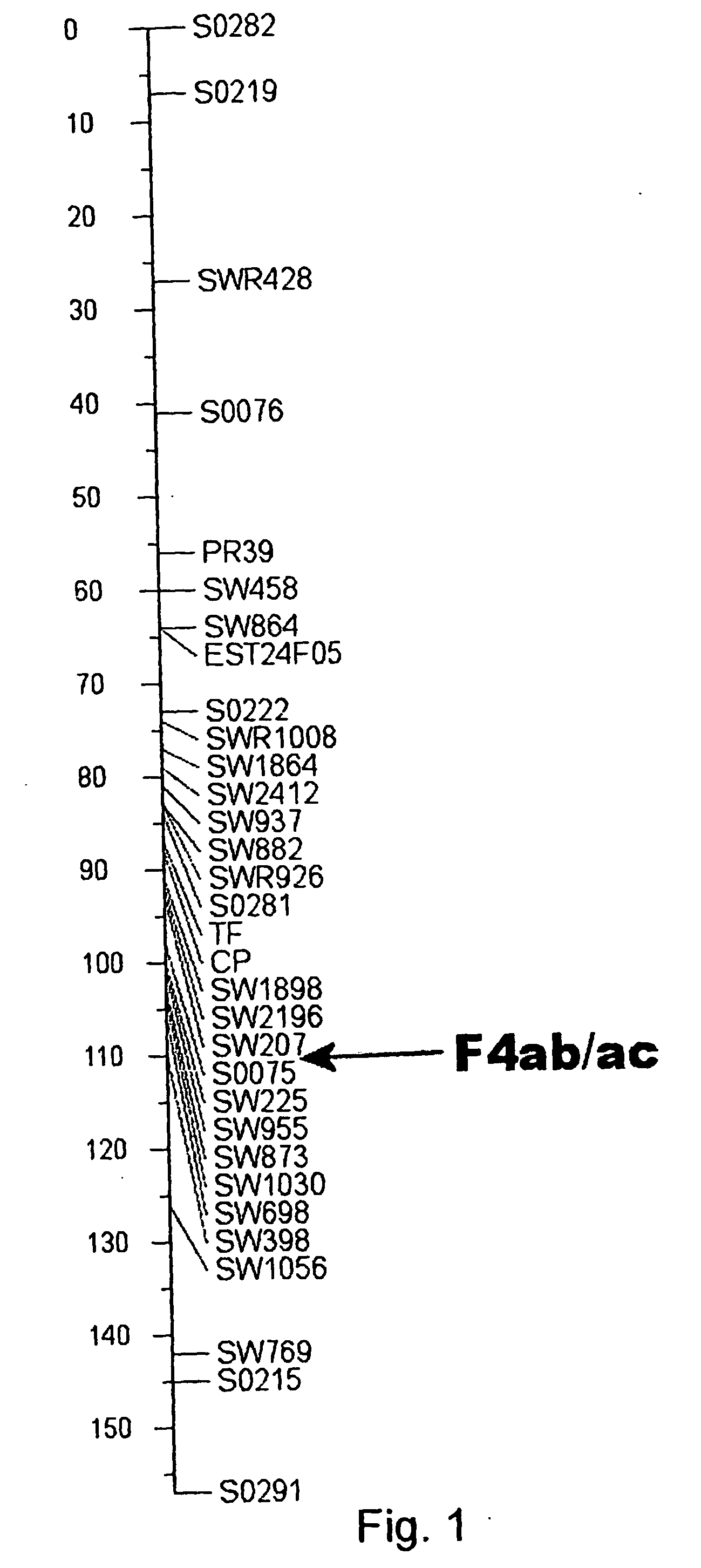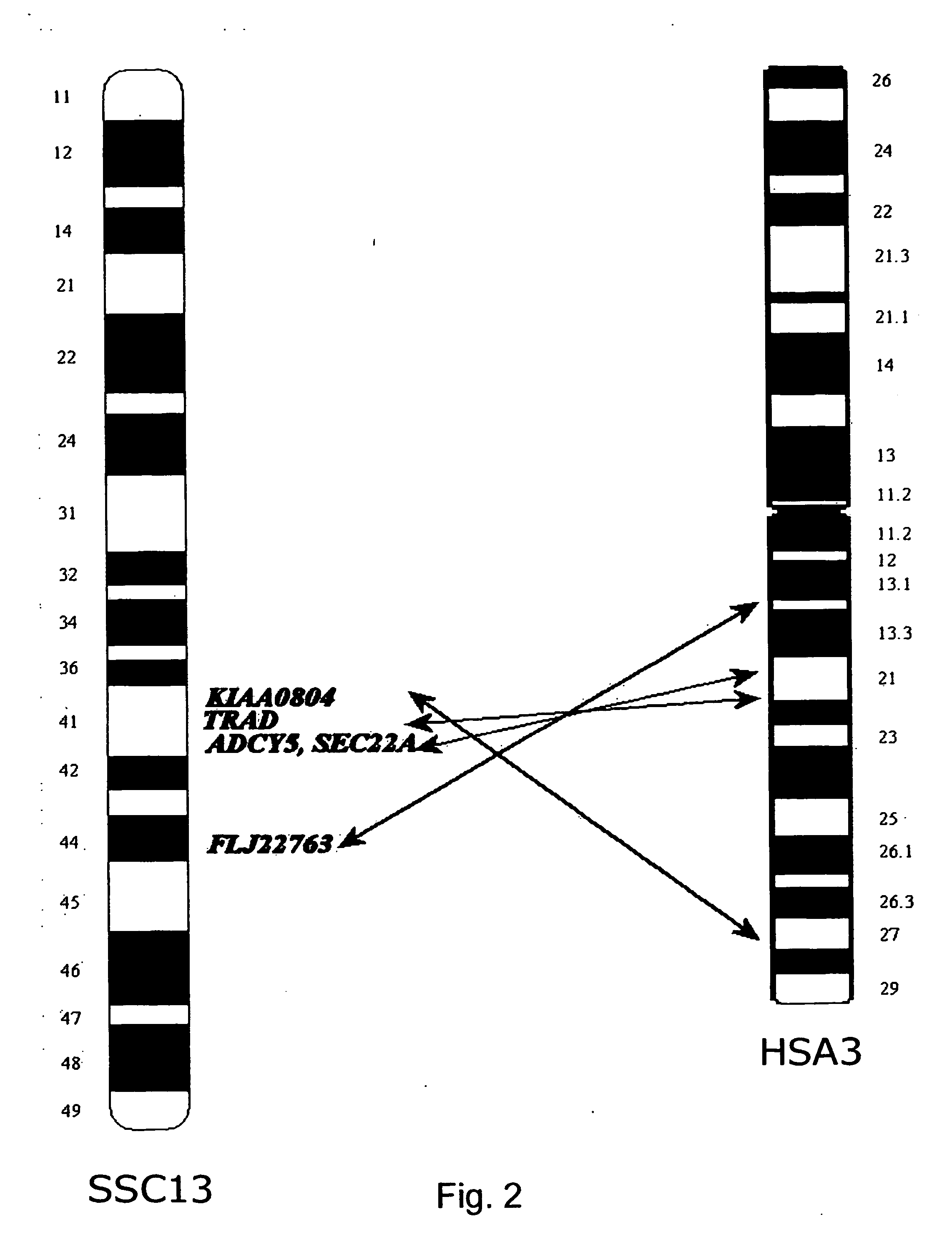Porcine polymorphisms and methods for detecting them
a polymorphism and polymorphism technology, applied in the identification field of pigs, can solve the problems of keeping the new-born, disease-free, most widespread and serious problems, etc., and achieve the effects of reducing the consumption of antibiotics, and fast test results
- Summary
- Abstract
- Description
- Claims
- Application Information
AI Technical Summary
Benefits of technology
Problems solved by technology
Method used
Image
Examples
example 1
Identification of the Gene Responsible for Resistance Towards E. coli ETEC F4ab / F4ac Diarrhoea
1.1. Introduction
[0172] In order to characterise the gene responsible for resistance towards E. coli F4ab / F4ac diarrhoea it was decided to rely on the so-called ‘positional candidate gene cloning’ strategy (Collins 1995). The starting point was the work described by Edfors-Lilja and co-workers in 1995. This study was significantly expanded by increasing the DNA-marker density on the pig chromosome 13 (SSC13) linkage map in the same intercross pedigree that was used in the Edfors-Lilja analysis. In addition the gene mapping in the chromosomal area where the gene responsible for resistance towards ETEC F4ab / F4ac is localised were significantly improved.
[0173] In the following the work is described that was carried out in order to identify candidate genes and resulted in the identification of polymorphisms in a candidate gene showing strong linkage disequilibrium with ETEC F4ab / F4ac status ...
example 2
2.1 Screening Pig BACs containing MUC4
[0205] In order to investigate if the MUC4 gene indeed is the gene responsible for resistance towards E. coli ETEC F4ab / F4ac diarrhoea, large portions of the gene were cloned and sequenced.
[0206] Plasmid S1325 containing a 3229 bp RACE PCR fragment of the human MUC4 cDNA (Moniaux et al., 1999) was obtained from prof. J. P. Aubert. The fragment was synthetised using total RNA from human colon mucosa. Advantage™ RT-for-PCR kit (Clontech, Heidelberg, Germany) was used to synthesize first-strand cDNA from 1 μg of RNA using the oligo (dT)-anchor primer of the 5′ / 3′-RACE kit (Boehringer Mannheim, Roche Diagnostics, Meylan, France). Expand long PCR was performed using Expand™ Long Template PCR System (Boehringer Mannheim) with the sense primer NAU 491 (5′-AGCAGGCCGAGTCTTGGATTA-3′, SEQ ID NO. 50), and as antisense primer the PCR anchor primer of the 5′ / 3′-RACE kit was used. The PCR amplification reaction mixture (50 μl) c...
example 3
Identifying Polymorphisms in the MUC4 Gene Linked to Resistance towards E. coli ETEC F4ab / F4ac Diarrhoea
[0215] To identify possible genetic variations in the porcine MUC4 gene that links to resistance towards E. coli ETEC F4ab / F4ac diarrhoea the sequence information obtained in example 2 was exploited as described.
[0216] After having generated the sequences of exons 4 and 8 the following PCR primers were designed:
SSMUC4_ex4U:5′-GAC TTC ACC TCG CCA CTC TT(SEQ ID NO. 60)SSMUC4_ex8L:5′-CGA TAC TTC TCC CAC ACT GG(SEQ ID NO. 61)
[0217] Using these primers on pig genomic DNA we generated an approximately 4 kb long range PCR product using Elongase (Invitrogen, Calif., USA). Initial denaturation was 94° C. for 2 min and 35 cycles 94° C. 30 s, 60° C. 1 min, 68° C 10 min. After amplification different enzymes were tested on amplified fragments from animals with known F4ab / F4ac genotype and a XbaI polymorphism was discovered.
3.1 Linkage Analysis with MUC4
[0218] The pedigree used in the li...
PUM
| Property | Measurement | Unit |
|---|---|---|
| volume | aaaaa | aaaaa |
| temperatures | aaaaa | aaaaa |
| temperatures | aaaaa | aaaaa |
Abstract
Description
Claims
Application Information
 Login to View More
Login to View More - R&D
- Intellectual Property
- Life Sciences
- Materials
- Tech Scout
- Unparalleled Data Quality
- Higher Quality Content
- 60% Fewer Hallucinations
Browse by: Latest US Patents, China's latest patents, Technical Efficacy Thesaurus, Application Domain, Technology Topic, Popular Technical Reports.
© 2025 PatSnap. All rights reserved.Legal|Privacy policy|Modern Slavery Act Transparency Statement|Sitemap|About US| Contact US: help@patsnap.com



